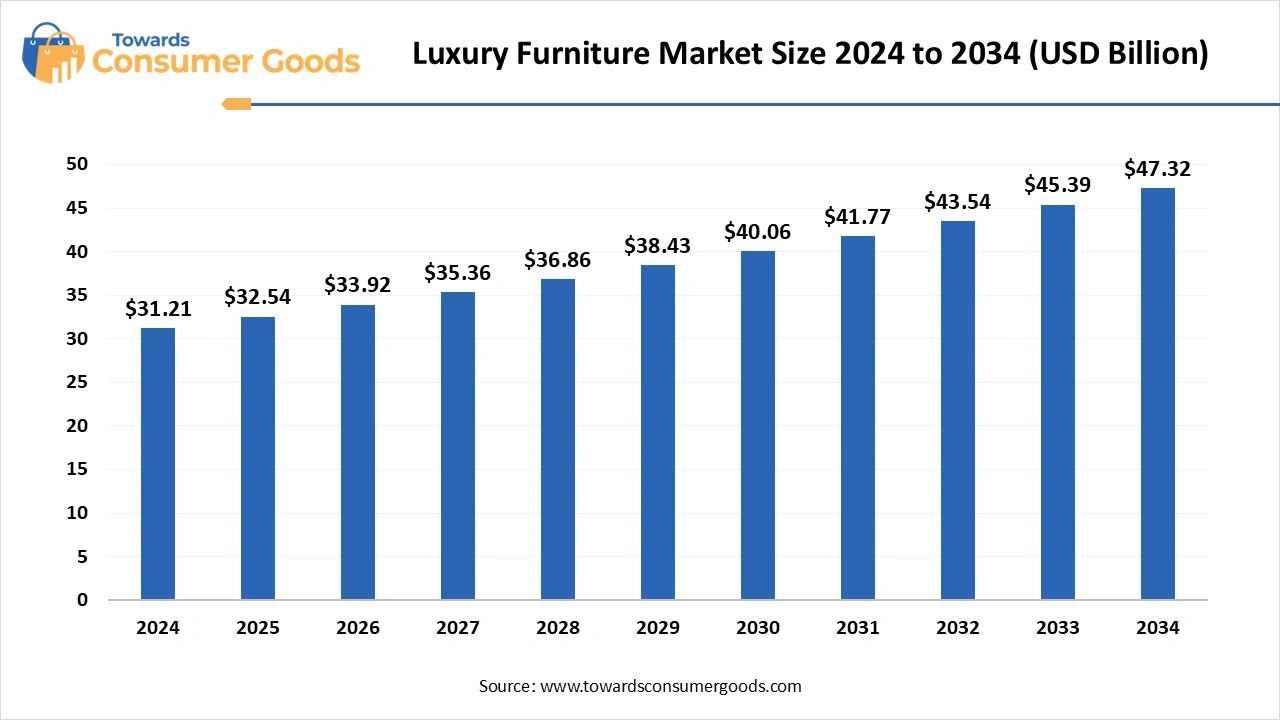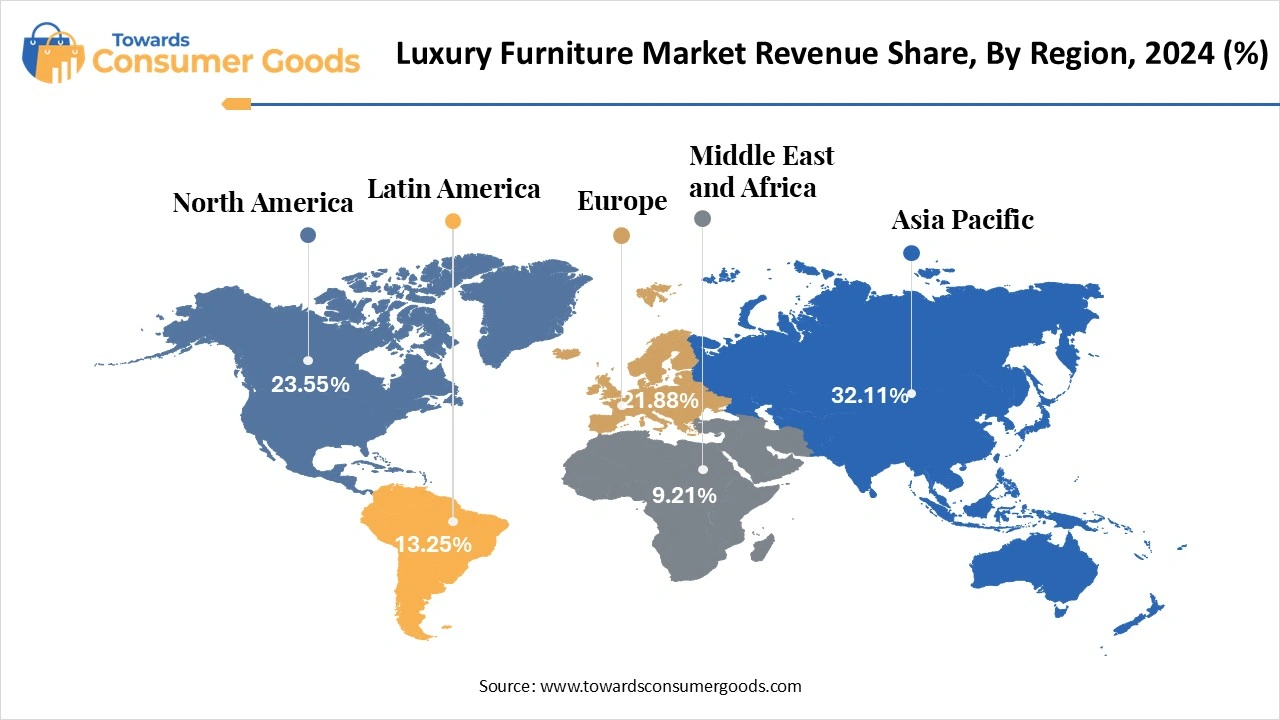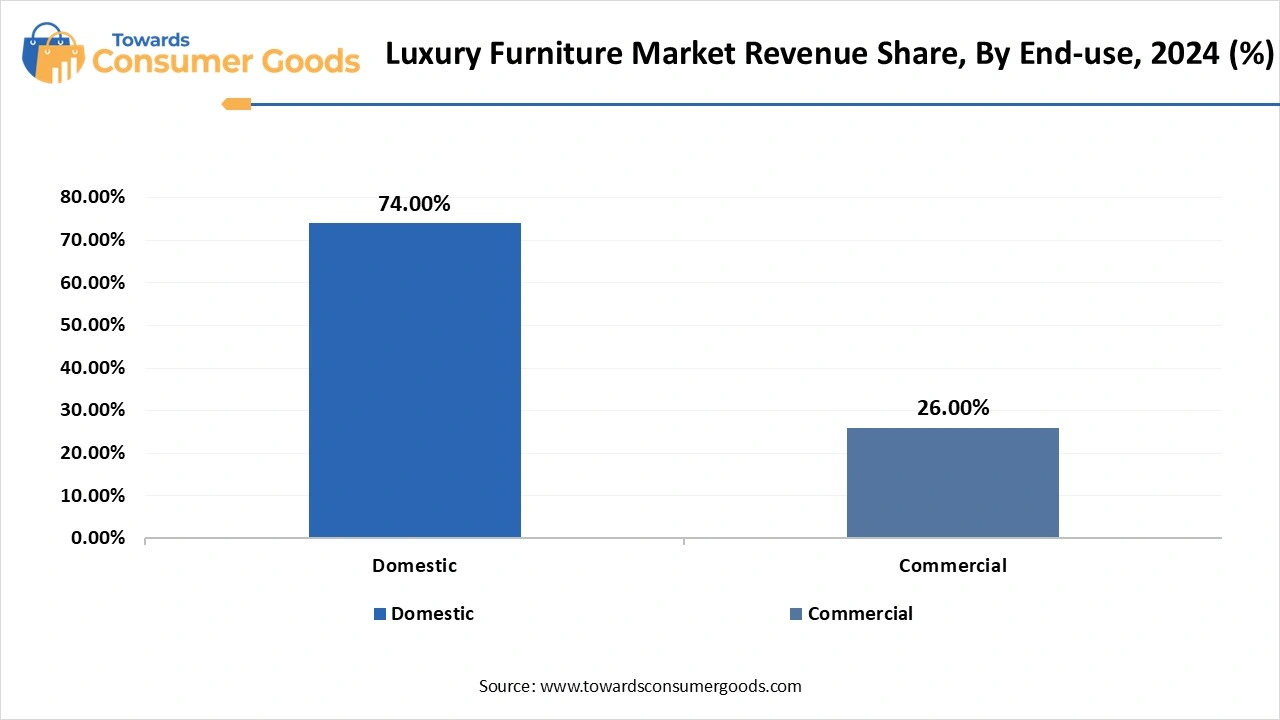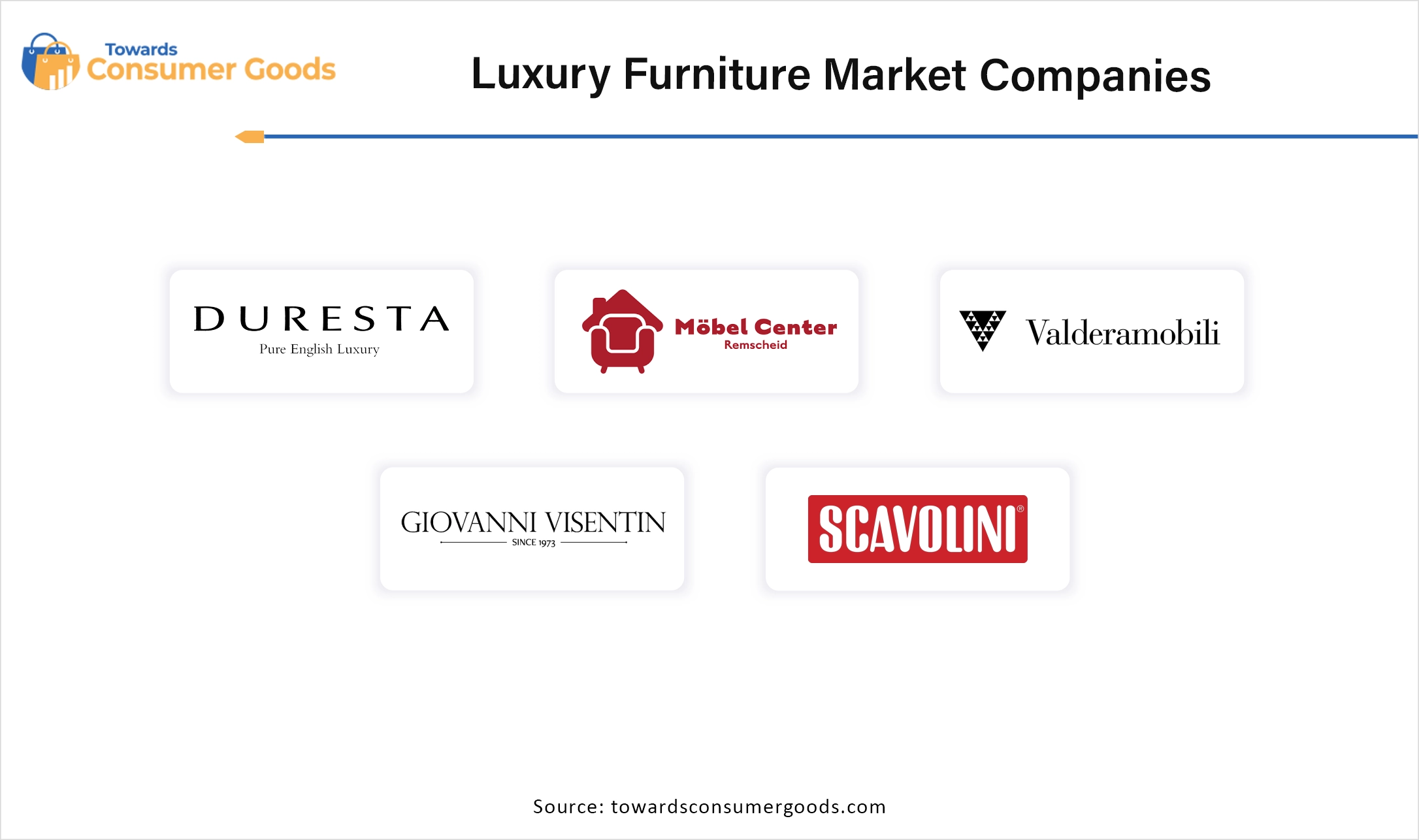July 2025
The luxury furniture market is estimated to increase from USD 32.54 billion in 2025 to USD 47.32 billion by 2034, The market is projected to record a CAGR of 4.25% during the forecast period from 2025 to 2034. The market is growing due to rising incomes, urbanisation, and more stores in developing economies.
As innovative and environmentally friendly items gain popularity, there is a significant change occurring in the luxury furniture market. Customers today prefer furniture that is both aesthetically pleasing and functional. Brands are concentrating on more environmentally friendly production techniques and improving online shopping experiences in response to the rising demand for sustainable living. The demand for fashionable furniture, particularly in homes, workplaces, and hotels, is also rising due to urbanisation, social media trends, and a thriving real estate market. Luxury furniture of today is constructed from high-quality materials like glass, metal, and wood and is available in a variety of sizes and forms to suit contemporary tastes.
As more people live in cities and have more disposable income, the worldwide market continues to grow. Furthermore, businesses are working hard to lower carbon emissions, proving that luxury can still be both stylish and environmentally responsible. This renewed balance between comfort, exquisite craftsmanship, and environmental consciousness is influencing the direction of luxury interior design. Consumers are looking for fashionable, durable, and sustainable options that fit their evolving lifestyles. All things considered, the industry's focus on flexibility, quality, and responsibility is guiding the luxury living space sector towards a more interesting and sustainable future.
| Report Attributes | Details |
| Market Size in 2025 | USD 32.54 Billion |
| Expected Size in 2034 | USD 47.32 billion |
| Growth Rate | CAGR of 4.25% |
| Base Year in Estimation | 2024 |
| Forecast Period | 2025-2034 |
| Dominant Region | The Asia |
| Segment Covered | By Material, By End-use, By Region |
| Key Companies Profiled | Nella Vetrina, Henredon, Giovanni Visentin, Duresta, Mobelcenter, LAURA ASHLEY HOLDINGS PLC, Iola Modern, Valderamobili, SCAVOLINI S.P.A. |
The luxury furniture market is expanding rapidly because of rising disposable income and a growing desire for elegant, stylish living. As families' incomes increase, they are showing a greater interest in expensive and sophisticated furnishings. In addition to homes, luxury furniture is also common in upscale hotels, modern offices, and co-working spaces. Many hospitality businesses are working with top designers to create distinctive furniture that combines comfort, toughness, and a luxurious look. These personalised goods improve client satisfaction and help organisations stand out.
The growing affordability of luxury furniture produced in nations like Germany and Italy is also helping the global economy. Because luxury furniture is becoming more widely available and more affordable for customers worldwide, the market is still expanding rapidly. By implementing these things, they can continue their business operations and prevent significant delays. One needs to be adaptable and prudent with production and sourcing to compete in today's high-end furniture industry.
The luxury furniture market is facing significant challenges as the cost of premium materials like rare wood, exquisite leather, and artisan metals keeps rising. These rising costs are pushing up production costs and reducing profit margins. A lack of raw materials and delayed shipping are two persistent problems with the global supply chain that are making it harder for companies to deliver orders on time. This affects the degree of brand trust that customers have, in addition to slowing down operations. To solve these issues, a lot of furniture manufacturers are changing their strategies. They're building local production facilities, increasing their stock levels, and collaborating with a wider range of vendors.
Asia Pacific dominated the market in 2024. The luxury furniture market in Asia-Pacific is increasing rapidly because of rising disposable incomes and urbanisation. Projects about hospitality and luxury real estate are growing quickly in countries like South Korea, Japan, China, and India. The growth of e-commerce, the appeal of global brands, and the increasing demand for stylish yet eco-friendly designs are other factors driving the industry's expansion. The Asia-Pacific luxury furniture industry is expanding because of the region's consumers' desire for upscale, modern furniture that fits their evolving lifestyles.

North America expects significant growth in the luxury furniture market during the forecast period. The market for luxury furniture is evolving along with how consumers furnish their new houses. Rich consumers today seek out special, meaningful products rather than just building up a huge collection. They prefer quality to quantity and are prepared to pay extra for items that enhance their surroundings and quality of life. This change demonstrates how modern luxury is more about creating enduring connections and influence than it is about merely possessing pricey items.
Europe is expected notable growth in the market during the forecast period. European demand for high-end home décor and exquisitely manufactured pieces has kept Europe at the forefront of the global luxury furniture business. Thanks to well-known brands and skilled craftspeople, nations like Italy, France, Germany, and the UK are setting the standard. The area's market is further stimulated by the appeal of upscale real estate and hospitality initiatives. Europe's emphasis on environmentally friendly methods is also helping it stay ahead of the competition by combining sustainability with style to keep its top spot in the luxury furniture market.
The wood segment dominated the luxury furniture market in 2024. Wood continues to be a popular material for luxury furniture because it combines strength, natural beauty, and affordability. Because it lasts a long time and adds cosiness to any environment, people love wooden furniture. What sets wooden furniture suppliers apart in the contemporary market is their emphasis on superb design—items with sophisticated designs, imaginative craftsmanship, and stylish finishes. Whether they are exhibited in showrooms or online, these thoughtful designs help businesses stand out and draw attention. Wooden furniture complements both conventional and modern designs, whether it is used for dining sets, coffee tables, beds, or cupboards.
Its ability to blend design and functionality makes it a smart choice for many homes. Because of its appeal and dependability, wood is still a popular option for customers looking to add a high-end feel to their interiors. The metal segment expects fastest growth in the luxury furniture market during the forecast period. Metal furniture is growing in popularity as a more durable and eco-friendly option than wood or plastic.
Environmentally conscious individuals are increasingly selecting metal products for their homes and workplaces. Finishes like gold, brass, and stainless steel not only enhance solidity but also give interior spaces a modern, stylish appearance. These materials help create a sleek, contemporary look that complements contemporary design principles. Because it adds a touch of sophistication and elegance, metal furniture is a fantastic choice for modern living spaces.
The domestic segment dominated the luxury furniture market with the largest share in 2024. Luxury furniture is growing in popularity as real estate developers and architects attempt to attract wealthy clients. To stand out, they are focusing on stylish, multifunctional products that fit the modern lifestyle of wealthy customers. High-end leather couches and fashionable folding couches with LED lighting features are examples of goods that are growing in popularity due to their ability to blend style and functionality.

Apart from their luxurious look, these furniture items give homes, offices, and lounges a sensible, small-space design. Due to its modern appearance, which goes well with lavish décor, they are a common option in high-end settings. This rise is being driven by the need to create more aesthetically pleasing and adaptable living spaces as well as the demand for design innovation. The market for luxury furniture keeps growing because designers and developers want elegant, multifunctional, and sophisticated furniture solutions.
The commercial segment is expected to grow significantly over the forecast period. The purpose of commercial luxury furniture is to improve the appearance and use of corporate areas such as workplaces, cafeterias, conference rooms, and lounges. Important components in this space are tables, chairs, and storage cabinets. In this industry, high-end office furniture is crucial. Luxurious office spaces are still becoming more and more popular, which further contributes to the market expansion.
Collaboration: In January 2025, Niso furniture has teamed up with Kornit Digital to launch a special home décor collection. The new line was first shown at Heimtextil 2025 in frankfurt. This partnership combines smart furniture design with eco-friendly digital printing technology.
Unit Expansion: In October 2024, DIVIANA has opened a 3200 square foot luxury furniture store in Milan's Montenapoleone District that showcases Indian craftsmanship and modern design, highlighting the nation's increasing impact on global design trends.
In December 2024, with the launch of its new Experience Centre in Gurgaon, Wriver is showcasing its commitment to eco-friendly design and cutting-edge furniture with the Lithic Series, which is constructed from recycled materials.

Based on comprehensive market projections, the global online home decor market size is calculated at USD 190.11 billion in 2024, grew to USD 204.67 bi...
According to market projections, the global men skincare products market, valued at USD 19.71 billion in 2024, is predicted to increase from USD 20.69...
As per current market projections, the global wedding services market size was estimated at USD 901.64 billion in 2024 and is predicted to increase fr...
According to Consulting experts, the U.S. luxury candle market size is calculated at USD 166.49 million in 2024, grew to USD 185.72 million in 20...
July 2025
July 2025
July 2025
July 2025